The Birthstone of November: Explore Citrine and Topaz
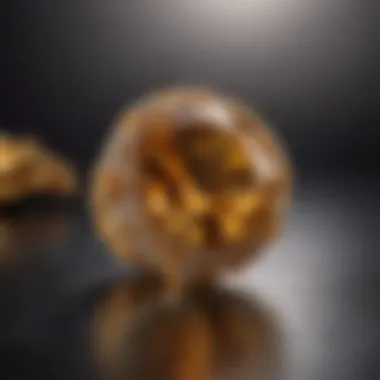
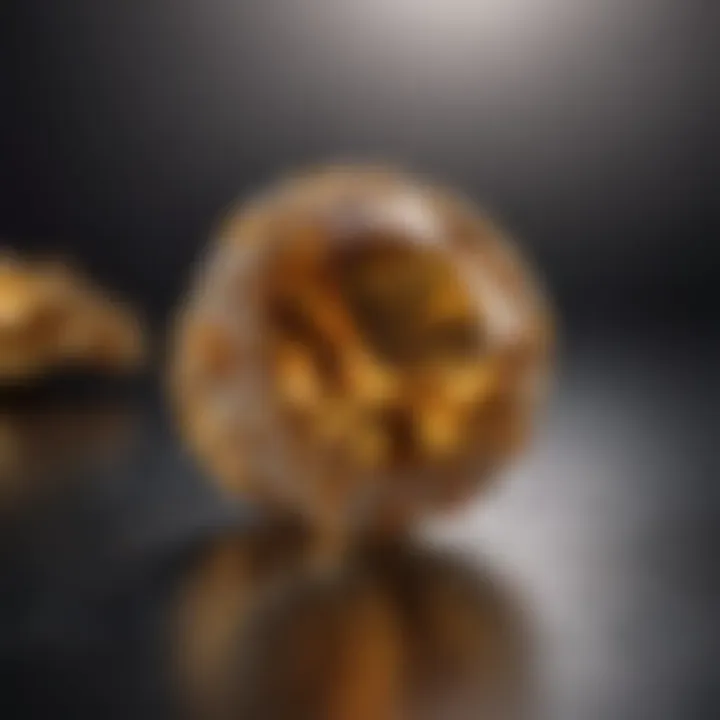
Intro
November is the month that often gets overlooked in the grand parade of celebrations, yet it harbors within it a hidden gem — quite literally. The birthstones for this month, citrine and topaz, carry not only visual allure but a depth of meaning that stretches across various cultures and epochs. Their vibrant hues and interesting properties compel us to delve deeper, going beyond their mere aesthetic to uncover tales of history, belief, and craftsmanship.
Gemstone Overview
Definition of Gemstones
In a nutshell, gemstones are minerals, rocks, or organic materials that have been cut and polished for adornment or ornamentation purposes. They must possess beauty, durability, and rarity. Each gemstone we encounter has its own persona, with variations in color, clarity, and texture that contribute to their appeal.
Classification of Gemstones
Gemstones can be classified into two primary categories: precious and semi-precious. While the former typically includes diamonds, rubies, sapphires, and emeralds, the latter encompasses a broad range of stones, including our stars of the month: citrine and topaz.
- Citrine: Known for its warm yellow and orange hues, citrine is believed to bring prosperity and joy.
- Topaz: Coming in a multi-colored array from blue to clear, topaz symbolizes strength and intellect.
Understanding these classifications is crucial, as they not only dictate market value but also influence what occurs in the minds of collectors and gemstone enthusiasts.
Historical Significance
When we peel back the layers of time, the role of gemstones becomes exceedingly clear. Understanding their significance helps put the allure of citrine and topaz in context.
Origins of Gemstone Use
The use of gemstones can be traced back to ancient civilizations where they were not just accessories but also cornerstones of spiritual and cultural rituals. For instance, early Egyptians wore jewelry adorned with semi-precious stones and believed them to be protective charms. Such practices laid the groundwork for future generations' relationships with these treasures of the earth.
Cultural Insights: Gemstones in Ancient Civilizations
Different cultures assigned distinct meanings to these stones. For example, in India, wearing topaz was thought to promote good health and was historically favored by royalty. In Greece, citrine was associated with the sun and joy, leading to its use in elegant jewelry pieces.
"Gemstones have long served not just as adornments, but as conduits of cultural identity and personal aspirations."
As we dive into the deeper narratives surrounding citrine and topaz, we see that their relevance transcends mere decoration; they symbolize aspirations, heritage, and beliefs across cultures. Exploring their historical significance enriches the appreciation of these dazzling stones in present-day jewelry.
Prelims to November Birthstones
Understanding the birthstones associated with November provides a window into the unique characteristics and rich histories tied to these gems. November is marked by the vibrant hues of citrine and the mystique of topaz; these stones do more than just adorn jewelry—they encapsulate cultural meanings, healing properties, and personal significance. Exploring this topic connects enthusiasts with the gems' beauty while unveiling their stories in a way that resonates deeply with both the heart and mind.
Significance of Birthstones
Birthstones have held a special place in human civilization for centuries. They are believed to offer protection, bring good luck, and possess unique metaphysical properties. In many cultures, wearing one's birthstone is thought to enhance the wearer’s personal energy and reinforce their identity. The practice can be traced back to ancient traditions where stones were linked to specific deities and were even utilized in religious rituals. The November birthstones, particularly, symbolize courage and strength, making them a favorable choice for those born under this month.
Moreover, birthstones serve as personalized gifts, especially during celebrations like birthdays and anniversaries. They convey a level of thoughtfulness and recognition of one’s individuality. The unique characteristics of citrine and topaz, combined with their historical and cultural significance, add layers of meaning that enrich the recipient’s experience.
Overview of November's Gems
When diving into the world of November’s birthstones, citrine and topaz each exhibit distinctive qualities that set them apart.
- Citrine is often celebrated for its warm yellow tones that radiate warmth and cheer. This stone is said to promote positivity, making it a sought-after choice for jewelry meant to uplift the spirit.
- Topaz, on the other hand, showcases a broader spectrum of colors, from the crystal-clear blue of the sky to intense amber hues. This stone’s versatility makes it popular among jewelers as it can be cut into various shapes and styles.
Both stones have transcended time, shaping jewelry design and cultural narratives through the ages. Their examination provides insights not only into their aesthetic qualities but also their ongoing relevance and appeal in modern craftsmanship. With each stone adopting its own identity rooted in history, exploring November's gems sets the stage for deeper appreciation of their role in gemstones conversation.
"The history of gemstones interweaves the artistry of nature and the creativity of humankind, offering a glimpse into both the past and the unfolding future of gemology."
As we proceed through the subsequent sections, we will delve into the distinctive qualities of each stone, examining their physical characteristics, historical contexts, and the technology behind their care. The journey of understanding November's birthstones is as colorful and rich as the stones themselves.
Citrine: The Main Birthstone of November
Citrine stands out as the primary gemstone for those born in November, not just for its vibrant hues but also for its extensive lore and significance. This gemstone holds a special place in both historical contexts and modern jewelry design. Its bright, sunny appearance evokes a sense of warmth, representing positivity and energy—qualities deeply cherished by individuals navigating the complexities of life.
Color Characteristics of Citrine
Shades of Yellow
Citrine is known for its delightful shades of yellow, ranging from pale lemon to deep, rich golden colors. This broad spectrum allows it to cater to different tastes and preferences. One of the remarkable features of these shades of yellow is their ability to catch light beautifully, creating a glow that can brighten any ensemble.
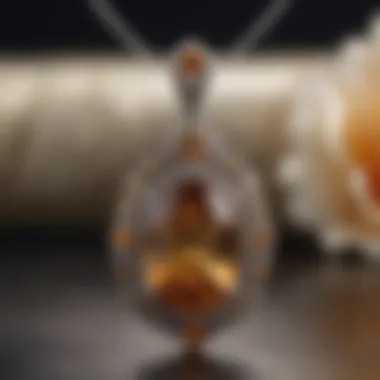
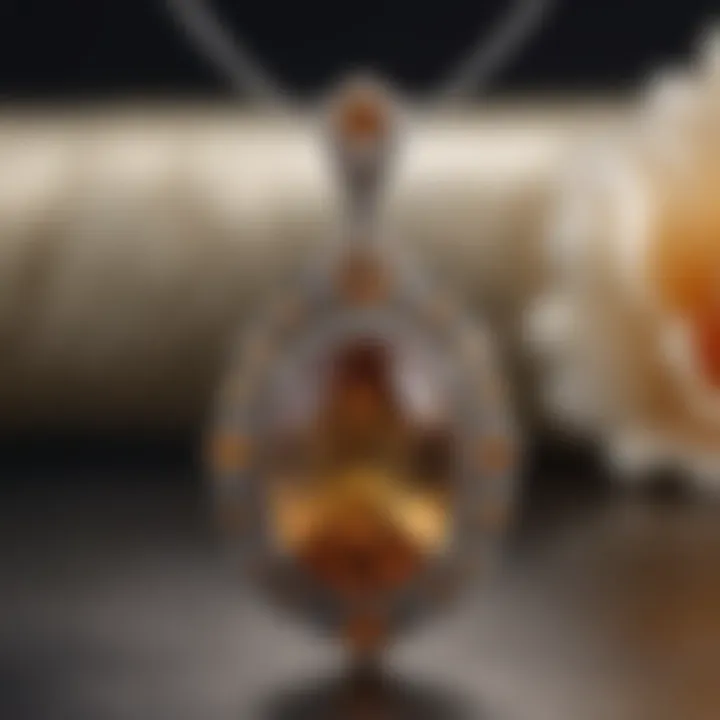
- Key Characteristics: The lighter shades often exude a subtlety that can be quite versatile, while the deeper hues draw attention and can act as a statement piece. This versatility is one reason citrine has become a popular choice for jewelry enthusiasts.
- Unique Features: Interestingly, the hue of citrine can change based on lighting conditions, making each piece of jewelry unique. The advantages of the lighter shades are that they complement a wider array of skin tones, making them a beneficial option for varied fashion choices.
Golden Hues
Transitioning from the typical yellows, citrine also features captivating golden hues. These deeper, richer tones not only elevate the aesthetic appeal but also symbolize wealth and prosperity. Many regard the golden hues as the embodiment of warmth and cheerfulness.
- Key Characteristics: The sense of luxury that golden citrine offers cannot be overstated, often associated with sunshine and optimism. This is especially appealing for those seeking a unique gemstone experience beyond just color.
- Unique Features: Golden citrine, with its slight orange undertones, invokes feelings of happiness. However, one must be cautious, as these darker shades can overshadow more delicate pieces if not balanced correctly. This attention to detail is crucial in crafting sophisticated jewelry designs.
Gemological Properties of Citrine
Hardness and Durability
In the gemstone world, citrine holds an impressive position with a hardness rating of 7 on the Mohs scale. This durability is invaluable for anyone looking to wear citrine on a daily basis.
- Key Characteristics: The hardness and durability of citrine make it an especially popular choice for rings and bracelets that endure everyday wear. This factor significantly reduces the likelihood of scratches and chips.
- Unique Features: Additionally, citrine’s resilience means it can be worn in various settings, ensuring long-lasting beauty. However, because of its specific conditions of care, it’s important to handle it gently during cleaning to maintain its luster.
Refractive Index
Citrine's refractive index, ranging from 1.54 to 1.58, plays a critical role in how effectively it reflects light. This quality leads to the striking brilliance that observers often admire.
- Key Characteristics: The refractive index contributes to the gemstone's overall shine, allowing it to dazzle in a multitude of lighting situations. A higher index often means a more pronounced sparkle, which is highly sought after in jewelry making.
- Unique Features: While this trait enhances its appeal, one downside can be that some lower-quality citrines may not capture as much light, affecting their visual allure. Hence, selecting high-quality stones becomes essential, especially for connoisseurs and collectors.
Historical Significance of Citrine
Ancient Beliefs
Citrine has been cherished since ancient times, with roots traceable to civilizations such as the Greeks and Romans. It was believed to carry properties of sun and light, often associated with healing and power.
- Key Characteristics: These ancient beliefs enriched citrine with meanings of safety and prosperity, making it a treasured gemstone in past cultures. The association with solar energy linked it to life, making it valuable and revered.
- Unique Features: Despite its rich history, one challenge is the lesser-known ancient customs surrounding citrine, often overshadowed by more prominent gems. This limitation can lead to reduced appreciation among modern enthusiasts who seek depth beyond the stones.
Use in Jewelry Through Ages
Historically, citrine has been utilized in various jewelry pieces throughout the ages—ranging from regal adornments to contemporary designs. Its transition reflects evolving tastes in our society.
- Key Characteristics: As fashion has shifted, the use in jewelry through the ages showcases how versatility has kept citrine relevant. Notably, during the Art Deco movement, citrine was widely embraced.
- Unique Features: What stands out is its adaptability; it’s equally suited for vintage-inspired pieces as well as minimalist designs. One disadvantage, however, is that the fluctuating popularity of citrine can sometimes lead to inconsistent quality in the market, which discerning buyers need to be wary of.
Those interested in integrating citrine into their collections should explore various styles and historical contexts to best appreciate this magnificent gem.
In summary, citrine, with its brilliant yellow shades and rich history, emerges as a meaningful gem for November. Its celebrated use in jewelry, coupled with its gemological properties, paints a holistic picture for enthusiasts, collectors, and designers alike.
Topaz: November's Alternate Birthstone
When one thinks of November's birthstones, citrine often steals the spotlight, but topaz deserves its moment in the sun too. While citrine embodies sunlight and warmth, topaz is a stone of clarity and calm. Its myriad color variations and rich history make it an essential complement to its month-long counterpart. Furthermore, topaz enhances the birthstone narrative with its own unique palette and symbolism, contributing to a broad understanding of what these gemstones can represent.
Color Variations of Topaz
Natural Color Range
Topaz comes in a feast of colors, from soft pinks to deep browns, but its natural range primarily includes yellows and browns. One of the key characteristics of topaz is its ability to exhibit color ranging from a light champagne hue to a rich, deeper amber. The variety in natural colors is not just eye candy; it's a significant aspect that speaks to the gemstone's versatility, making it a go-to choice for many jewelry designers. Natural topaz is often a more affordable option compared to its treated counterparts and poses a sustainable choice for collectors. One unique feature of topaz's natural color is its clarity; it can be remarkably free from inclusions, which adds to its appeal. However, it's essential to be aware that natural stones can show slight variations in shade, which can be either an advantage or disadvantage depending on the buyer’s preference.
Blue Topaz: A Distinct Variant
Blue topaz has become quite popular and is cultivated with a distinct ocean-like clarity that many find alluring. The key characteristic of blue topaz is its vibrant hue, which can range from very light to a deeper, more saturated blue, sometimes resembling the ocean on a clear day. Its popularity in the market can be attributed to this striking color that can complement a range of skin tones and styles. Moreover, blue topaz is often enhanced through a process called irradiation, making it more accessible and often cheaper than other blue stones like sapphire. The unique feature of blue topaz lies in its affordability paired with a vivid color palette. However, this treatment can somewhat diminish its natural value, which may concern purists.
Identifying Features of Topaz
Understanding Clarity
When it comes to gemstones, clarity is a crucial factor, and topaz stands out in this regard. The clarity of topaz contributes significantly to its appeal, giving it an inviting look that many collectors love. A prominent characteristic of topaz is that it is often found to be nearly flawless, which elevates its desirability. This clarity allows for better light reflection and enhances its brilliance. In terms of advantages, clarity means that topaz can be set in a variety of designs without the worry of noticeable flaws. However, a discerning eye will spot that even the finest examples can possess minor inclusions under magnification, which may affect the quality rating.
Imperfections and Inclusions
Contrary to clarity, some buyers find charm in imperfections. Inclusions can tell a story about a stone's formation and history, offering a narrative that appeals to collectors. The key characteristic of imperfections in topaz often leads to fascinating mineral formations or color zoning that can add character to the gemstone. While many choose flawless stones, those with slight inclusions can be unique treasures. The unique feature of such imperfections lies in their ability to make each stone one-of-a-kind. However, buyers should be careful, as certain inclusions can also affect durability and how the stone holds up over time.
Cultural Relevance of Topaz
Myths and Legends
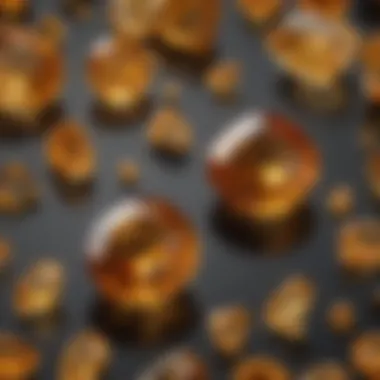
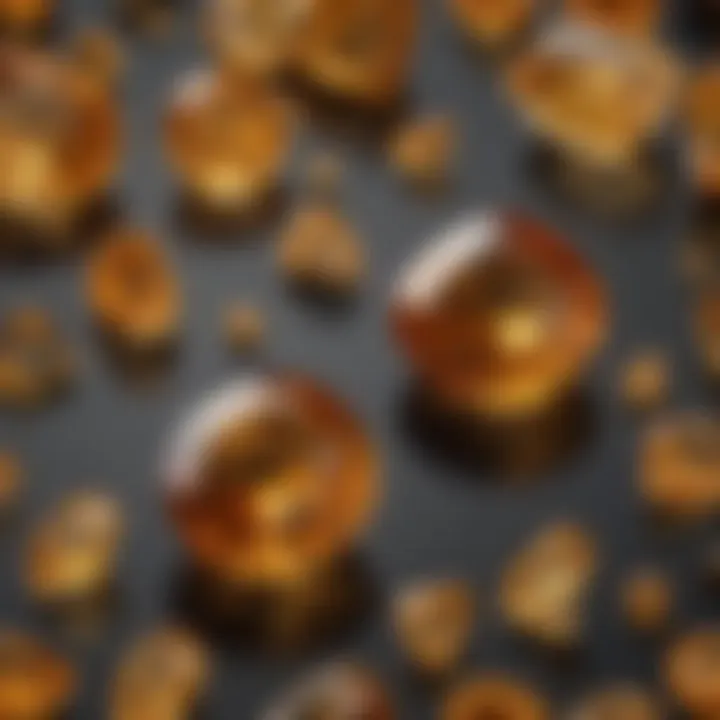
Throughout history, topaz has been steeped in myths and legends. Many cultures have attributed specific meanings to it, believing it brings peace and good fortune. The key characteristic of topaz in folklore is its association with protection against envious spirits. This cultural depth adds an intriguing layer to the stone's appeal. These stories not only enhance the gemstone's allure but also help in enriching its significance in modern jewelry. One unique aspect of topaz's mythos is its association with the sun, believed to bring warmth and light to the wearer's life. Conversely, with such strong beliefs comes the challenge of discerning marketing from genuine lore. Nonetheless, this rich history makes topaz a perpetual favorite among enthusiasts.
Fashion Trends
Topaz is not just a relic; it remains highly relevant in modern fashion trends. Its versatility makes it suitable for various styles, from minimalist designs to extravagant pieces. The key characteristic driving fashion trends around topaz is its compatibility with different metals and settings, allowing it to shine in various forms of jewelry. Unique features often seen include its placement in both antique and modern designs; it transcends time by fitting seamlessly into vintage-inspired artwork while also being the star player in contemporary collections. However, as trends change, buyers may find that overly trendy pieces don’t age well, so a balance is essential.
Symbolism and Meaning of November Birthstones
November birthstones hold a significant place not just in the realm of gemstones, but also in the hearts of those who cherish their meanings. These stones, citrine and topaz, symbolize more than mere beauty; they encapsulate energy, vitality, emotional healing, and even astrological significance which resonate with many individuals who seek strength and solace through their connection to these gems. By exploring their symbolism, one can find personal meaning and a deeper appreciation for these magnificent birthstones.
Healing Properties
Energy and Vitality
The concept of energy and vitality attributed to gemstones like citrine is often highlighted for its remarkable ability to invigorate both the spirit and the body. Many believe that citrine, with its vibrant golden hues, can boost one's energy levels while improving overall vitality. This trace of brightness isn’t just a color; it represents a spark of life. The unique feature here is how this stone harnesses positive energy, making it a popular choice among those looking to cultivate positivity in their lives.
For individuals who may feel weighed down by daily stresses, citrine provides a beacon of light. By carrying or wearing this stone, enthusiasts claim they feel empowered, ready to tackle whatever comes their way. However, it’s worth noting that the effects of such gemstones are subjective, and the belief systems surrounding them can vary widely.
Emotional Healing
Now, let’s delve into emotional healing, another crucial aspect surrounding the symbolism of November's birthstones. Those who find solace in topaz often appreciate its reputed power to heal emotional wounds. With its calming presence, topaz is believed to aid in overcoming negative emotions and enhancing self-acceptance. This gem’s soothing energy is described as a gentle reminder to connect with one’s feelings and ground oneself.
Unlike some stones that project a powerful intensity, topaz delivers a more nurturing vibe. It invites tranquility and peace, which can encourage individuals to engage in introspection. While it may not turn every frown upside down, its balanced nature is a great ally for those navigating complex emotional waters.
Astrological Significance
Zodiac Compatibility
When considering the astrological significance of November birthstones, zodiac compatibility plays a central role. Citrine and topaz are often associated with those born under the signs of Scorpio and Sagittarius. The belief is that these stones can enhance the positive traits associated with these zodiac signs, fostering growth and self-awareness.
Scorpios, known for their intensity and passion, may find support in the invigorating energy of citrine. This stone can amplify their determination, making it easier to pursue goals. On the other hand, Sagittarius individuals can benefit from topaz's calming energy, helping them clarify their thoughts and navigate their often insatiable quest for knowledge. Notably, this connection between birthstones and zodiac signs can deepen an individual’s sense of identity.
Influence on Personal Traits
Diving further, the influence of these gems on personal traits is a fascinating concept. The characteristics attributed to citrine and topaz can reflect or enhance specific traits of those born in November. Citrine is often credited with infusing optimism, creativity, and an infectious enthusiasm that encourages exploration.
Topaz, in contrast, embodies stability, patience, and wisdom, making it a valuable tool for understanding oneself better. Its impact on emotional clarity can help individuals shine a light on their personal journeys, guiding them through beneficial changes in their lives. These traits both empower and enrich the identities of those who cherish these birthstones,
"The strength of a gem is not just in its beauty, but in what it signifies about ourselves and our journeys through life."
Care and Maintenance of Citrine and Topaz
Caring for your citrine and topaz ensures these beautiful stones maintain their brilliance and allure. A little bit of effort goes a long way in preserving the quality of your gems. It’s worth noting that both of these stones can endure some wear and tear, but taking proper care can help prolong their lifespans and showcase their beauty in the best light.
Cleaning Techniques
Recommended Cleaning Solutions
When it comes to cleaning your gemstones, it’s all about striking a balance between effectiveness and gentleness. Warm soapy water is a classic go-to solution for many gemstone enthusiasts. The main benefit is its safety; it won’t damage the stones and is also effective at removing dirt and oils that can accumulate over time.
You can use a mild dish soap mixed with lukewarm water. Remember, hot water may cause thermal shock!
Another alternative is an ultrasonic cleaner, which works wonders for well-set jewels. This device creates high-frequency sound waves, shaking off grime and dirt. However, use this with some caution; not all gemstones are suitable for this method. Citrine, for example, typically handles ultrasonic cleaning well, while light-colored topaz can be prone to fading with excessive cleaning.
Avoiding Harmful Chemicals
It’s crucial to steer clear of harsh chemicals when cleaning your gems. Many cleaning agents contain ammonia or bleach, which can wreak havoc on your stones and their settings. For instance, ammonia can lead to clouding in topaz or even weaken the adhesive used in some jewelry.
Instead, focusing on natural cleaning supplies or specifically formulated gemstone cleaners is a much safer alternative. These products have a key characteristic of being less abrasive, thus providing effective cleaning without compromising the integrity of the stones.
Additionally, using a soft cloth to gently polish your gemstones after cleaning can help restore their shine. It’s a simple yet effective step in maintaining your jewelry’s sparkle. Overall, keeping clear of chemicals is a valuable rule to follow, helping preserve both the beauty and durability of citrine and topaz.
Storing Your Stones
Optimal Conditions


How you store your gemstones makes a significant difference in their longevity. Both citrine and topaz fare best in a cool, dry environment, that keeps them away from direct sunlight. Prolonged exposure to intense sunlight can cause topaz to lose its vivid color over time.
Consider investing in soft pouches or the classic velvet lined boxes. These can protect your stones from scratches or damage when they rub against harder materials. It's smart to store each piece separately, avoiding the risk of them scratching one another, especially with those pesky hard rocks. This way, your gems are kept in optimal conditions that promote their vibrancy while preventing deterioration.
Preventing Damage
Preventing damage isn’t just about storing your stones correctly. It’s also about being mindful of when and where you wear them. Heavy lifting or activities that increase chances of impact could expose your gemstones to unwarranted stress. For instance, common wear during gardening or sports may expose them to chips or cracks.
Also, before cleaning or storing, it’s wise to inspect your jewelry for any loose parts. Addressing issues proactively can help avoid larger, costlier repairs down the line. Adopting a mindful approach to usage and storage can help maintain the overall integrity of your prized possessions.
"A little care goes a long way when it comes to your September gems. Every small effort adds up to long-lasting beauty."
In summary, these practices in care and maintenance will not only sustain the aesthetic appeal of your citrine and topaz items but also celebrate their innate qualities for many years to come.
The Role of November Birthstones in Jewelry
November's birthstones, citrine and topaz, hold a pivotal role in the jewelry world. Beyond their aesthetic appeal, they offer personal meaning to those born in this month, making them more than just adornments. The incorporation of these stones into jewelry pieces speaks to individual identity, sentiment, and craftsmanship. In this section, we’ll explore the various ways these gems contribute to the art of jewelry-making.
Design Trends
Contemporary Styles
Contemporary jewelry design is often marked by bold expressions and innovative approaches. With citrine and topaz making a significant mark, contemporary styles are a go-to for modern jewelry collectors. A key characteristic of these styles is their focus on minimalist aesthetics yet striking colors, making these gems pop without overwhelming the piece.
Often set in unconventional shapes or paired with mixed materials like metals and glass, citrine and topaz can transform a simple ring or pendant into a conversation starter. However, one must tread lightly; trendy pieces may become dated, which can impact their sentimental value over time.
Classic Inspirations
On the flip side, classic inspirations in jewelry design harness the timeless elegance of citrine and topaz, appealing to those who prefer tradition. The hallmark of classic designs is their detail and craftsmanship, often reflecting historical styles ranging from Art Deco to Victorian.
These designs have a way of transcending trends, providing durability both in style and quality. While they might lack the edginess of contemporary pieces, their unique feature lies in their versatility and ability to endure through generations. But keep in mind, classic styles may require more investment upfront due to their intricate detailing and high-quality finishes.
Craftsmanship and Artisanship
Importance of Quality
The quality of materials and craftsmanship in jewelry cannot be overlooked. When discussing the importance of quality in citrine and topaz jewelry, the best pieces often feature exquisite facets and finely polished finishes. Investing in high-quality stones ensures that your jewelry not only looks good but also stands the test of time. One cannot emphasize enough that quality ensures longevity and preserves the integrity of the design. Yet, high-quality pieces often come with a hefty price tag, posing a challenge for some collectors.
Master Jewelers’ Techniques
Master jewelers employ time-honored techniques that can elevate the mere presence of citrine and topaz into masterpieces. Skills such as stone setting, engraving, and metalworking play a crucial role. Shedding light on this craft reveals how it brings out the vibrant colors and enhances the overall aesthetic.
A unique aspect of master jewelers' work is their meticulous attention to detail, ensuring no facet goes unnoticed. Nonetheless, the challenge lies in finding these skilled artisans, as their expertise can come at a premium.
“The beauty of a well-crafted piece speaks volumes about the effort that went into it.”
Culmination: Appreciating November's Gemstones
As we reach the end of our exploration into November’s birthstones, it's essential to take a moment and appreciate their unique beauty and significance. Birthstones do not merely serve as decorative elements in jewelry; they embody historical, emotional, and cultural meanings that resonate deeply with those born in this month. Citrine and topaz each carry distinct characteristics that reflect the warmth and vibrancy of November, a month often associated with gratitude and reflection.
Understanding the importance of these gemstones can enhance your connection to them, whether you wear them yourself or gift them to others. Their gemological properties and broad spectrum of colors indicate both aesthetic appeal and versatility in jewelry making. Each stone carries memories of ancient cultures and continues to inspire modern designs and trends.
"In every piece of jewelry, there’s a story waiting to be told."
Whether one chooses to wear citrine for its sunny hues or topaz for its dazzling clarity, each choice represents personal style and emotional connection. Caring for these stones, maintaining their clarity and brilliance, truly goes hand in hand with their appreciation. As you learn more about how to care for and choose these gems, your connection to their beauty grows.
Personal Reflection on Birthstones
When we reflect on our birthstones, it often transcends the mere act of wearing them. For many, it's a journey of self-discovery and connection to their roots. Birthstones like citrine and topaz can evoke personal memories or serve as markers of significant life events. It could be a family heirloom passed through generations, or perhaps a gift received on a milestone occasion like a birthday or anniversary.
Citrine, with its warm yellow tones, is often seen as a stone that brings joy and prosperity. Its historical significance suggests it was used in ancient times to ward off evil spirits. On the other hand, topaz resonates with themes of love and loyalty. These meanings add depth to your understanding and appreciation of the stones beyond their physical appearance.
- Citrine:
- Topaz:
- Symbol of positivity and energy
- Associated with abundance and wealth
- Represents love and affection
- Associated with healing and mental clarity
Reflecting upon these personal connections can enrich the experience of owning or gifting jewelry that features these birthstones.
Encouraging Knowledge and Appreciation
Encouraging a deeper knowledge and appreciation of November's gemstones goes beyond a casual understanding. Education about the geological formation, sourcing, and the craftsmanship behind citrine and topaz can enhance your experience as a gemstone enthusiast.
- Research: Understand where these stones originate and how their colors are formed. For example, did you know some topaz is treated to enhance its blue hue?
- Experiential Learning: Visit exhibitions or gemstone shows to see these stones up close and personal. This experience can shift perspectives on their value.
- Community Engagement: Join forums or social media groups where you can exchange stories and insights about birthstones. Websites like Reddit and Facebook have vibrant communities of gemstone lovers sharing tips and experiences.
Ultimately, the more knowledge you accumulate, the richer your interaction with these stones will be. Taking the time to learn about their history, properties, and current trends in jewelry design adds a layer of appreciation that goes beyond aesthetic appeal. Supporting artisans who create with integrity and understanding the ethical considerations in gemstone sourcing is also crucial.
Understanding and appreciating your birthstones can lead to a lifelong relationship with these unique gifts from the earth, each possessing its own story and allure. November's gemstones, citrine and topaz, are not just a celebration of the month but also an ode to personal significance, legacy, and creativity.



